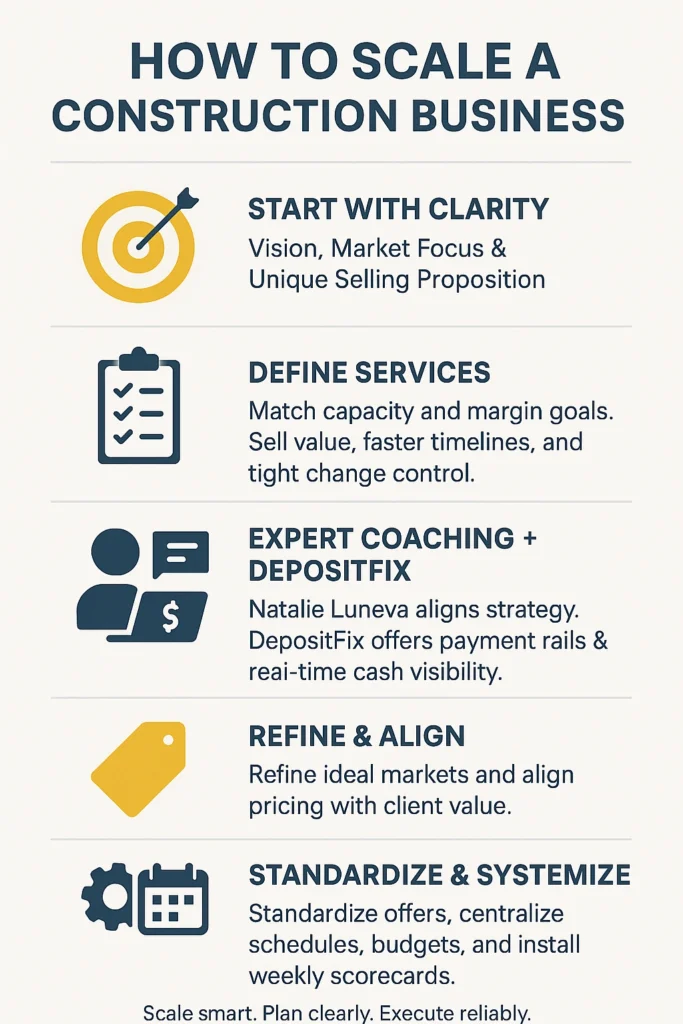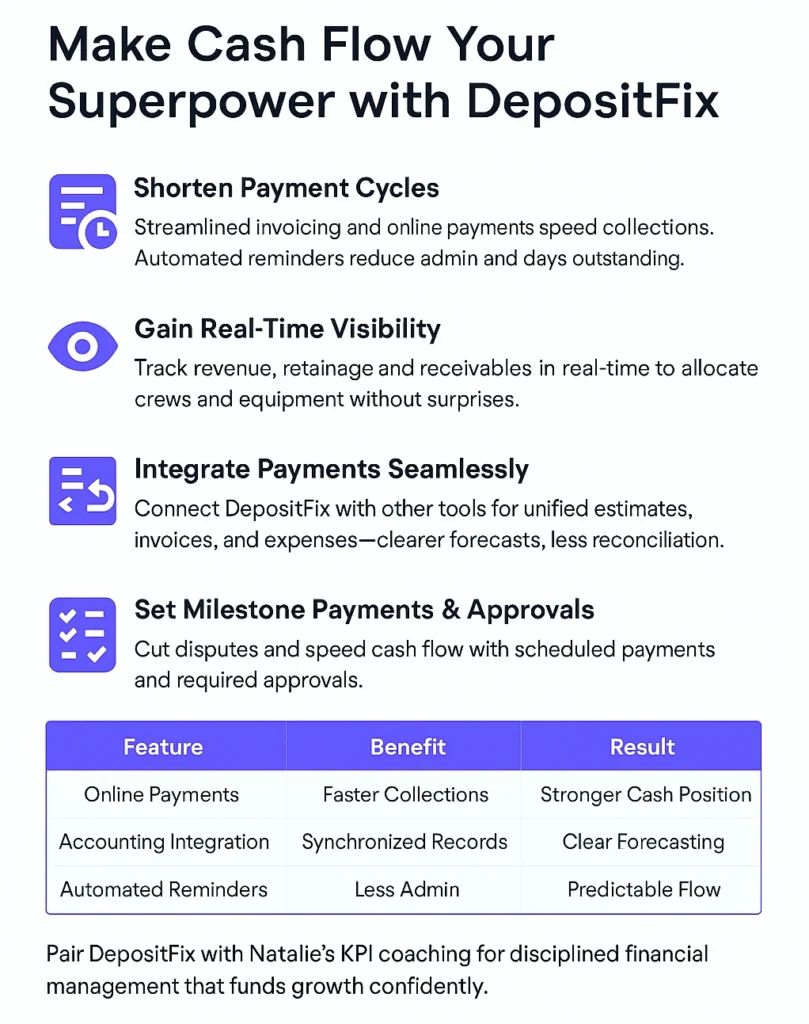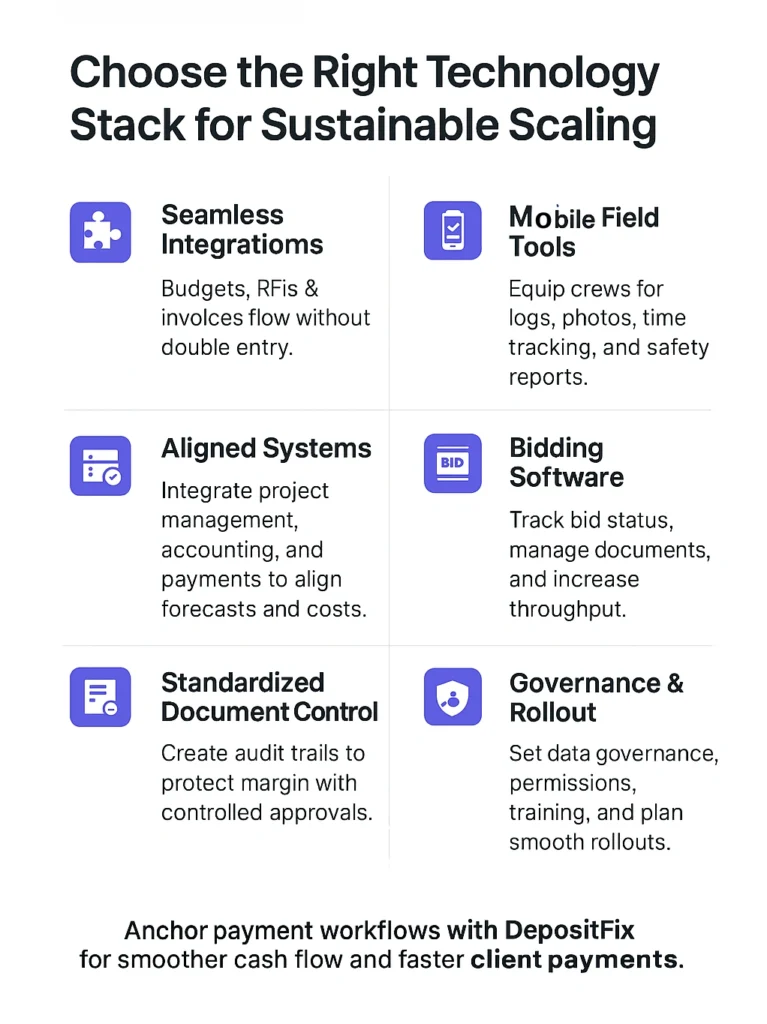You need a clear plan if you want steady growth and lasting success in your firm. Scaling your construction business means more than bigger crews or higher revenue. It means building repeatable systems, reliable delivery, and healthy margins.
Natalie Luneva’s coaching gives you a strategy-led playbook. Her approach clarifies vision, sharpens market focus, and aligns people with measurable goals. Pair that with DepositFix and you get faster payments, better cash flow visibility, and accounting that ties to real-time figures.
Standardized processes and digital tools drive predictable results. Teams that use project scheduling, integrated accounting, and CRM-led marketing see fewer delays and less rework.
This guide previews core levers you will optimize: planning, organizational design, hiring, scheduling, sales systems, and the right tech stack. You’ll move from doing work in the field to leading a firm with clear KPIs and practical reports.
Key Takeaways
- Scaling means systems. It’s about consistent delivery and compounding profit.
- Adopt a strategy-led roadmap that aligns operations, people, and finances.
- Natalie Luneva’s coaching helps set measurable goals and market focus.
- DepositFix shortens payment cycles and links payments with accounting.
- Optimize planning, hiring, scheduling, and the tech stack for reliable growth.
Build a scalable foundation for your construction company
Begin with a strategic base that aligns people, finances, and project delivery. A clear plan defines values, purpose, and five-to-ten-year goals, then turns those into annual S.M.A.R.T. objectives you can inspect weekly and monthly.
Create a strategic plan tied to measurable outcomes.
Create a strategic business plan tied to measurable outcomes
Set annual targets and link each target to metrics: backlog, win rate, project margin, WIP, and cash conversion. Natalie Luneva helps formalize this plan while DepositFix ensures invoicing and payments match your operational rhythm.
Design an organizational structure that supports growth
Choose flat, functional, or divisional models so reporting lines are clear and decisions move faster. Map roles, responsibilities, and handoffs to remove overlap and gaps.
Standardize repeatable processes for consistent delivery
Document estimating, scheduling, change orders, procurement, and closeout. Use templates, checklists, and training so each crew meets the same quality standard regardless of project size.
- Plan annual objectives with S.M.A.R.T. metrics you review regularly.
- Pick the org model that fits your workload and client mix.
- Map roles, own each step of every process, and measure results.
- Protect capacity and plan people, equipment, and capital needs.
| Focus Area | Key Action | Outcome | Tools |
| Planning | Annual S.M.A.R.T. objectives | Clear priorities and measurable progress | KPIs, dashboards |
| Organizational Design | Flat / Functional / Divisional model | Faster decisions and fewer handoff errors | Org charts, role matrices |
| Processes | Standardize estimates and closeouts | Predictable delivery and higher efficiency | Templates, checklists, training |
Tie the plan to your financial systems so invoicing, payments, and accounting integration scale with projected growth. This keeps operations stable and resources ready when demand rises.
How to scale a construction business
Pinpoint who your ideal client is and what makes your work different. Clear market focus and a concise USP turn vague goals into concrete offers. When you name target sectors and project types, planning becomes actionable and proposals convert faster.
Start with clarity: vision, market focus, and your unique selling proposition
Define services that match capacity and margin goals. Create scopes that sell on value, faster timelines, better communication, or tight change control.
Pair expert coaching from Natalie Luneva with DepositFix for a growth-ready system
Natalie aligns positioning, pricing, and delivery with measurable outcomes. DepositFix supplies payment rails and real-time cash visibility so strategy turns into reliable execution.
- Refine ideal markets and align pricing with client value.
- Standardize offers and handoffs to protect margin as projects multiply.
- Use software and tools to centralize schedules, budgets, and communication.
- Install weekly rhythms and scorecards so teams stay synced as volume rises.

Strengthen your team to scale: hiring, roles, and culture
Strong teams and clear roles turn hiring pressure into steady performance. About 80% of contractors report struggles finding qualified employees. You can reduce that strain with defined roles and repeatable hiring systems.
Create role maps for project managers, site leads, estimators, and coordinators. Map current and future positions so growth does not breed overlap or gaps. Clear reporting lines speed decisions and improve field–office communication.
- Create hiring scorecards that list must-have skills and measurable outcomes.
- Use structured onboarding that shortens ramp time and reinforces safety.
- Set meeting cadences that link site updates with operations and management.
- Offer apprenticeship tracks and partnerships to widen your talent pool.
Natalie provides interview frameworks, scorecards, and onboarding plans that standardize selection and culture building. DepositFix smooths cash flow so payroll runs on time, an important edge when you compete for top talent.
| Focus | Action | Benefit |
| Hiring | Scorecards & sourcing | Better selection quality |
| Onboarding | Structured training | Faster productivity |
| Culture | Documented expectations | Retention and ownership |
Master project management to prevent delays and protect margins
Strong project controls stop small delays from becoming big problems. You’ll build schedules that expose the critical path, show float, and list milestones. Update those plans weekly so your team reacts before issues cascade.
Standardized change routines keep scope moves visible. Log changes immediately, price them quickly, and get approvals before work proceeds. That practice protects margin and shortens dispute cycles.
Build reliable schedules and change management routines
Centralize RFIs, submittals, daily logs, and photos so field and office share one source of truth. Use checklists for punch and closeout so you finish clean, bill faster, and cut warranty work.
Use project management software to centralize budgets, tasks, and communication
Pick software that ties budgets to committed costs and forecast-to-complete. Integrated accounting gives real-time cost and revenue views that stop margin slippage and link operational performance to cash flow.
- Create baseline schedules with critical path, float, and weekly updates.
- Implement formal change control that logs scope shifts and secures approvals.
- Centralize communications and documents to speed decisions and reduce rework.
- Track line‑by‑line budget variances and forecast completion to defend margins.
- Measure schedule variance, change order cycle time, and DSO so you see cash flow impacts.
| Focus | Action | Benefit |
| Scheduling | Weekly baseline updates | Fewer cascading delays |
| Change control | Immediate logging and pricing | Protected margin |
| Visibility | PM software + integrated accounting | Real-time cost and cash insight |
Natalie Luneva helps you standardize scheduling, change control, and field–office communication. DepositFix keeps cash predictable as schedules shift so delivery quality and margin stay protected.
Make cash flow your superpower with DepositFix
Turn predictable receipts into strategic fuel for expansion with smarter payment systems. DepositFix pairs online payments, automated invoicing, and real-time tracking so you keep cash positive and act fast.
Shorten payment cycles with streamlined invoicing and online payments
Accelerate collections and send invoices that accept payments instantly. Automated reminders cut admin time and reduce days outstanding.
Gain real-time visibility into revenue and costs to fund growth
Link transaction feeds to dashboards that show cash, retainage, and aged receivables. That visibility helps you allocate crews and equipment without surprises.
Integrate payments with your accounting and estimating tools
Sync DepositFix with other tools so estimates, invoices, and expenses live in one source of truth. This reduces reconciliation work and gives your finance team clearer forecasts.
- Set milestone payment schedules and require documented approvals to cut disputes and speed time to cash.
- Monitor cash conversion cycles and WIP so hiring and marketing decisions rely on real data.
- Use a simple dashboard example to flag delayed change orders or slow clients early.

Scale your pipeline: marketing, sales, and conversion systems
A steady pipeline turns sporadic work into predictable revenue and staff schedules. You’ll refine target client profiles, run focused campaigns, and use clear messaging that appeals to project pains like schedule risk and cost certainty.
Refine your ideal client, then execute targeted campaigns and social media
Define sectors where your team, processes, and margins are strongest. Build campaigns across social media, email, and partner channels that speak to those clients.
Implement CRM-driven lead nurturing and data-driven decisions
Use CRM automation to qualify leads, track stages, and nurture prospects with case studies and project updates. Standardize proposals with clear scopes, schedules, and payment terms.
- DepositFix removes payment friction in proposals so clients can pay deposits online and lock schedules.
- Analyze cost per lead, conversion rate, and deal size weekly to fund high-ROI channels.
- Align sales promises with operations to protect margin and client satisfaction after award.
| Focus | Action | Metric | Result |
| Targeting | Ideal client profiles | Win rate by sector | Higher-quality leads |
| Channels | Social media & email | Cost per lead | Scalable outreach |
| CRM | Automation & nurture | Conversion rate | Faster decision cycles |
| Proposals | Standard scopes + online deposits | Deposit conversion | Secure bookings, better cash |
Choose the right technology stack for sustainable scaling
Focus on integrations that let budgets, RFIs, and invoices flow without double entry. Map core processes, estimating, bidding, scheduling, field reporting, and closeout, so you pick software and tools that reduce handoffs and errors.
Integrate project management, accounting, and payment systems so forecasts and costs stay aligned. This improves visibility across operations and speeds decision making.
- Standardize document control and approvals to create audit trails that protect margin.
- Equip field crews with mobile tools for daily logs, photos, time tracking, and safety reports.
- Use bidding software to track status, manage documents, and increase throughput.
- Set governance for data, user permissions, and training so adoption sticks.
Build a simple rollout plan that sequences systems, limits disruption, and delivers quick wins. DepositFix should anchor payment workflows, linking deposits, invoicing, and your accounting platform for smoother cash flow and faster client payments. Contact us today and scale your construction business!

Conclusion
Close the loop between planning and execution so every project fuels future growth. , This approach makes growth repeatable and lowers risk when you expand.
Use Natalie Luneva’s coaching for strategy, roles, and operating rhythms, and pair that with DepositFix for clear cash flow and faster deposits. That pairing is the fastest, safest way to scale construction business without breaking systems or margins.
Make weekly inspections of pipeline, WIP, DSO, and margin trends. Act on data early, standardize learning, and protect time with clear escalation paths for changes and delays.
With disciplined processes, CRM-led marketing, and integrated tools you will grow with fewer surprises and more repeatable wins.
FAQs
What are the biggest common pitfalls to avoid when scaling a construction business?
Scaling too fast without solid systems can lead to cash flow issues, poor quality control, and staff burnout. Lack of standardization and unclear roles cause inefficiencies that multiply with growth. Avoid overextending resources before stabilizing operations.
How do you measure whether your construction business is ready to scale?
Key readiness indicators include consistent project profitability, repeatable processes, steady cash flow, and a stable core team. If you frequently face delays, margin slippage, or hiring bottlenecks, focus on fixing these before expanding.
How do milestone payments benefit contractors and clients during growth?
Milestone payments reduce financial risk by linking cash flow to project progress. Contractors get paid steadily, avoiding costly delays. Clients gain transparency and assurance that work aligns with budgets and schedules, boosting trust.
What financial KPIs should I track to monitor my construction business’s growth?
Important KPIs include backlog (work booked but not started), win rate (percentage of bids won), project margin, work-in-progress (WIP) value, and days sales outstanding (DSO). These metrics highlight profitability, efficiency, and cash flow health.


